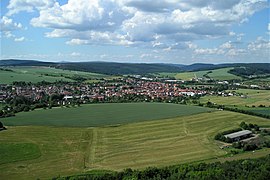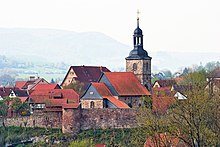Walldorf (Meiningen)
|
Walldorf
City of Meiningen
|
|
|---|---|
| Coordinates: 50 ° 37 ′ 0 ″ N , 10 ° 22 ′ 59 ″ E | |
| Height : | 290 m |
| Area : | 12.16 km² |
| Residents : | 2123 (Dec. 31, 2019) |
| Population density : | 175 inhabitants / km² |
| Incorporation : | 1st January 2019 |
| Postal code : | 98617 |
| Area code : | 03693 |
|
Fortified church
|
|
Walldorf ( ) is a district of the district town of Meiningen in the Franconian south of Thuringia .
geography
Walldorf is located at the confluence of the Herpf in the Werra between the Rhön and the Thuringian Forest , four kilometers north of the core town of Meiningen. The neighboring towns include Melkers, Wasungen and, as already mentioned, Meiningen. Wasungen and Meiningen can be reached via the B19 federal road. Melkers but also Meiningen can be reached via the country road.
history
Walldorf was first mentioned on October 1st, 982, when Emperor Otto II transferred his royal estate Walldorf to the Church of St. Peter and Alexander in Aschaffenburg . The original document is in the Aschaffenburg City and Abbey Archives . On May 7, 1008 gave Henry II. The Bishopric of Würzburg Walldorf as a fief . On February 27, 1221, Bishop Otto I of Würzburg confirmed the right of patronage over the Walldorf church to the church in Meiningen.
Parakeet and Wilhelm Marschalk acquired the Walldorf estate in 1410. In 1542 Walldorf came to the county of Henneberg -Schleusingen in exchange with the Meiningen exclave , which ended the rule of Würzburg. The Würzburg knights' fiefs over Walldorf, which were not mentioned in this exchange contract, remained with the diocese until 1808 after long battles.
After the Counts of Henneberg died out , Walldorf came under the rule of the Dukes of Saxony in 1583 . In 1584 the first Jews settled in Walldorf. They laid out a cemetery in the 18th century and created a school and a synagogue .
On October 17, 1634, the church and parts of the village were burned down as a result of the Thirty Years War . During the Seven Years' War (1757–1763) over 7,500 soldiers and 2,300 horses were billeted in Walldorf. At times three noble families were settled in the village: those of Ostheim, those of Bibra zu Irmelshausen and those of Walldorf. The village of Walldorf had belonged to the Imperial Knighthood since the 17th century and after its dissolution came to the Grand Duchy of Würzburg . In an exchange agreement from 1808, it was repurchased by Sachsen-Meiningen and has since belonged to the Meiningen office again .
During the Napoleonic Wars (1805-1814) the residents had to pay for a total of 34,000 billets, which meant a considerable burden for the place. In 1809, Duke Bernhard II of Saxony-Meiningen was granted sovereignty over Walldorf under the tutelage of his mother Louise Eleonore .
From 1867 onwards, the law on freedom of movement led to the increased emigration of Jews from Walldorf, which in 1849 had a maximum of 562 people out of a total of 1637 inhabitants.
Of the Walldorf men, 43 fell victim to the war in World War I and 115 in World War II. The bridges over the Werra and the Herpf were destroyed towards the end of the Second World War. In April 1945 US troops moved into Walldorf and set up a tent camp at the weir. Based on the decisions of the Allies , Soviet troops took over the administration in July 1945 and the Americans left Thuringia. Walldorf became part of the Soviet occupation zone and later the GDR . In the course of the land reform , Baron von Bibra's possessions were expropriated without compensation in 1946 and handed over to poor farmers. From 1950 to 1990 Walldorf was in the circle Meiningen the district Suhl the GDR, since 1994 it is part of Schmalkalden-Meiningen.
The fortified church of Walldorf , built in the 16th century, was badly damaged by fire on April 3, 2012. The Walldorf Castle , one built in the 18th century manor house was listed and was still stopped in October, 2013.
As part of the Thuringia regional reform in 2018 and 2019 , the voluntary integration into the city of Meiningen was decided on April 27, 2017, the contract was concluded on February 27, 2018. With the publication of the law on the reorganization of the municipalities in 2019 in the Free State of Thuringia, Walldorf was incorporated on January 1, 2019 as a district of the city of Meiningen.
politics
District Council
The district council of Walldorf consists of ten council members. The district councilor and mayor of the district have their seat in the Kressehof in Walldorf (Werra).
Until the incorporation in 2019, the municipal council consisted of 14 councilors and councilors. The last local council was elected in the local elections on May 25, 2014 . It led to the following result: Die Linke (41.0% and 6 seats), CDU (38.6% and 5 seats), SPD (20.4% and 3 seats).
In the local elections on May 26, 2019 , ten new council members were elected, all of whom belong to the electoral community “CDU-SPD-Die Linke”. Council members Marco Thomas (CDU) and Katharina Nennstiel (SPD) represent Walldorf in the Meiningen city council as part of their party membership.
District Mayor
Ute Pfeiffer ( Die Linke ) is the district mayor of Walldorf . She was elected honorary mayor on June 5, 2016 with 59.1% of the valid votes and became mayor of the district on January 1, 2019. She replaced Matthäus Hildebrand, who was elected on June 27, 2004 and re-elected on June 6, 2010 with 95.9% of the valid votes.
Town twinning
- Walldorf (Baden) since 2007
Culture and sights
Buildings
- The Walldorf church castle with outbuildings and defensive wall dates from the 16th century. On April 3, 2012, the church was badly damaged by a major fire, with numerous art treasures being destroyed. Reconstruction began in 2012. In May 2019 the solemn rededication of the church with modern interior took place.
monument
- Walldorf sandstone and fairytale cave , an underground labyrinth on an area of 65,000 square meters supported by 2,500 columns. The former mine, from which scouring sand was extracted, has become a magnet for visitors.
Historical monuments
- Walldorf's synagogue , of which only the basement remains today, was formerly a barn with a basement of the von Marschalk property. A completely weathered stone, on which the von Marschalk family's coat of arms and the year 1593 can hardly be seen today, is located above the arched cellar door. The barn was rebuilt between 1789 and 1791. The Jewish community, Oberforstmeister Chr. E. Freiherr Marschalk von Ostheim, gave the place to the synagogue. It was an artless half-timbered building. The holy ark was more richly furnished, similar in structure to some Christian altars at the end of the 18th century. In the middle stood the shrine for the Torah scrolls . This shrine was bordered on both sides by two pillars and two pilasters that supported a cornice. This was crowned by two eagles holding the tablets of the law , next to it two stucco flower vases. The large main candlestick for eight candles was made around 1789. The eight candles were intended for the eight days of the Hanukkah feast . Three chandeliers made of sheet metal, also from 1789, hung on the women's gallery. There were also old ceilings and hangings, fabrics from the 18th century, some good gold brocade silk, and hangings made of velvet with colored prints. Today a plaque commemorates the desecration of the synagogue on Tanzberg during the November pogrom in 1938 , which was followed by the forced sale and in 1949 the eventual demolition due to the risk of collapse. The ten Jewish families still resident in the village at the beginning of the National Socialist persecution were driven into emigration by 1941 at the latest or in 1942 abandoned to their extermination in two deportations; a single person survived.
- Walldorf Castle : helped shape the appearance of Walldorf until it was demolished in October 2013. It was the former Marschalk Castle from the 18th century, which had served as a retirement and nursing home from the mid-19th century until 1997. The demolition took place against the resistance of the State Office for Monument Protection.
- Vocational students from the Walldorf training center took part in the construction of several objects in the National Monument Sculpture Park German Unity .
Sports
Walldorf is located on the Rhön-Rennsteig hiking trail and the Werra valley bike trail . The sports club SV 1921 Walldorf operates the sports of soccer (currently the district upper league Rhön-Rennsteig) and table tennis .
Economy and Infrastructure
traffic
Walldorf is located on Bundesstraße 19 ( Eisenach - Meiningen ) and has a train station on the Werra Railway (Eisenach - Meiningen - Eisfeld line ), which is served by the STB 41 line of the Südthüringenbahn .
Health & safety
The Walldorf district has a volunteer fire brigade . This is run together with the Wallbach fire brigade as guard 5 of the Meiningen fire brigade.
Born in Walldorf
- Ferdinand Elsbach (1864–1931), German businessman
- Luise Danz (1917–2009), guard in various concentration camps
Individual evidence
- ^ Residents' registration office of the city of Meiningen
- ↑ Hans Kratzer: The emperor's sloppy document. In: www.sueddeutsche.de. July 11, 2020, accessed July 11, 2020 .
- ↑ Historical description of the county of Henneberg, part 3 .
- ↑ exchange of territory in 1808 Rhon lexicon .
- ↑ Official timetable of the community of Walldorf (Werra).
- ↑ http://www.insuedthueringen.de/region/meiningen/meiningen/Aus-Walldorf-wird-jetzt-Meiningen;art83442,5491770
- ↑ inSüdthüringen.de Walldorf-and-Meiningen-have-sealed-the-marriage.
- ↑ Thuringian Law and Ordinance Gazette No. 14/2018 p. 795 ff. , Accessed on December 29, 2018
- ^ Thuringian State Office for Statistics, 2014 municipal council election in Thuringia - final result for Walldorf
- ^ Free State of Thuringia, Mayoral elections 2016
- ^ Thuringian State Office for Statistics, Elected Mayors - current state overview .
- ^ Paul Lehfeldt , Georg Voss: Architectural and Art Monuments of Thuringia. Duchy of Saxony-Meiningen. Volume 1, Department 1: Georg Voss: Meiningen district. District court districts Meiningen. (The city of Meiningen and the country towns). Gustav Fischer, Jena 1909, p. 570 .
- ^ Thuringian Association of the Persecuted of the Nazi Regime - Association of Antifascists and Study Group of German Resistance 1933–1945 (Ed.): Local history guide to sites of resistance and persecution 1933–1945: Series: Heimatgeschichtliche Wegweiser Volume 8 Thuringia, Erfurt 2003, ISBN 3- 88864-343-0 , p. 262.
- ↑ Wolfgang Hirsch: Demolition excavators create definitive solutions. Two mansions disappear from the list of monuments. In: Thüringische Landeszeitung , February 7, 2014.






